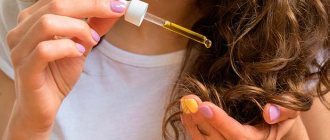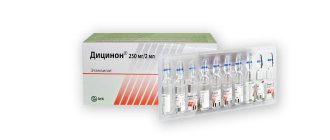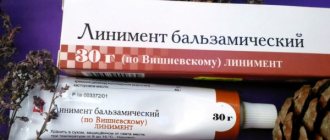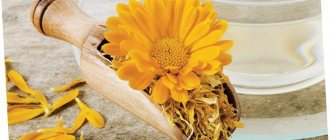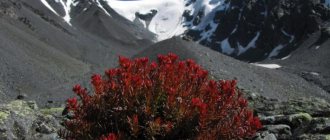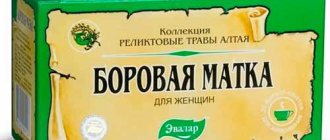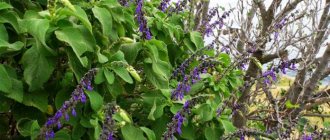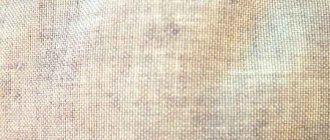It is difficult to say how many beneficial properties ordinary and well-known herbs contain. In almost every yard you can find a real “first aid kit” that can cure all kinds of ailments in a matter of days and is absolutely harmless. Few people know that during bleeding, nettle is an invaluable assistant, capable of coping with various types of bleeding, both internal and external. The only thing you need to learn is how to use this healing herb correctly.
Recipe
Now let’s discuss how to prepare a nettle decoction, be it a purchased plant or the leaves you collected:
- Pour one tablespoon of leaves into 0.2 liters of water;
- Boil;
- Leave to sit under a towel for an hour;
- Strain and cool.
How to drink nettle decoction for various diseases?
- For anemia and weakened immunity, 50 ml before each meal;
- For impaired blood clotting, 200 ml per day, divided into four equal doses;
- For diabetes mellitus, a glass daily;
- If you have skin problems, take a glass a day orally or to wipe the affected areas with a cotton pad;
- For external and internal bleeding, 4 glasses daily;
- To combat obesity and speed up metabolism, it is enough to drink 50 ml daily (in four doses);
- To strengthen your hair, wash it with liquid every morning;
- To normalize the functioning of the nervous system and improve sleep, you need to drink a glass a day, dividing it into small portions.
Nettle decoctions: application
Also, decoctions obtained from stinging nettle are used as a remedy:
- diuretic;
- during constipation;
- for epilepsy;
- for nervous diseases;
- with periodontal disease;
- for stomatitis.
Back in the 20th century, nettle was recommended as a medicine for:
- enteritis;
- diarrhea;
- diseases of the urinary system;
- problems with the gastrointestinal tract;
- burns;
- thrush.
Do not forget about the use of stinging nettle for hair and skin care.
Using nettle for bleeding
Nettle for bleeding has found application not only in folk medicine, but also in traditional medicine. The hemostatic properties of nettle are explained by the presence in its composition of a special antihemorrhagic vitamin K, which stimulates the formation of prothrombin in the liver, one of the main blood clotting factors, esculen, as well as a large amount of vitamin C.
Using nettle for menstruation
To make menstruation less heavy and eliminate uterine bleeding, nettle leaves are used, which must be collected in dry weather during flowering. For excessive menstrual bleeding, you can take freshly squeezed juice from nettle leaves orally. Need 1 tsp. dilute juice in ¼ tbsp. water and drink this decoction 3 times a day 20 minutes before meals.
In addition, it is advisable to avoid sports and heavy physical activity. If you take a mixture of fresh juices of nettle and yarrow leaves orally, then liquid nettle extract reduces blood output during menstruation. Infusion from a fresh plant, nettle decoction, and juice extract constrict blood vessels and tone the smooth muscles of the uterus.
By regularly taking liquid nettle extract 20-35 drops 3 times a day, you can achieve a hemostatic effect and normalize your menstrual cycle. Nettle has a mild anti-inflammatory effect, which is used to treat uterine fibroids and helps avoid large blood loss during menstruation.
In addition, it normalizes the onset of the next menstruation. To prepare a nettle decoction for heavy periods, you need to take 1 tablespoon for 1 glass of boiling water. stinging nettle leaves, leave, let cool and drink 3 times a day, 1 tbsp.
Using nettle for uterine bleeding
To prepare a nettle decoction to stop uterine bleeding, you need to brew 1 tbsp. chopped nettle in 1 cup of boiling water, boil for 10 minutes over low heat, then strain. Take 4-5 times a day, 2 tbsp.
Using the medicinal properties of nettle for cervical erosion
Using traditional medicine, for example, nettle decoction, you can supplement the main treatment of cervical erosion. Tampons for local use in the vagina, soaked in freshly squeezed juice of crushed nettle (from 5-6 branches), will help get rid of the bacterial environment in the intimate area, which often accompanies erosion.
The time the tampon is in place should not exceed 1-2 hours; this method of treatment can be used for up to 7-10 days. At the same time, doctors recommend getting more rest.
Nettle for vaginitis and colpitis
An important role is played by nettle in diseases of the female genital area such as colpitis and vaginitis caused by opportunistic bacteria. To combat inflammation of the vagina, you need to prepare an infusion for douching. Take a 250 ml mug of boiling water, pour 2 tbsp. chopped nettle rhizome and place over medium heat for 25 minutes.
5 minutes before the end of boiling, pour 1 tbsp into the water. nettles Then strain the broth and cool. You can douche 2-3 times a day using a special syringe. To avoid infection in the vagina, the douche must be boiled before and after the procedure.
Nettle treatment for internal bleeding
Nettle has found application for the treatment of internal bleeding, for which you need to brew 1 tbsp. dry crushed nettle leaves 1 tbsp. boiling water, put in a water bath, cook for 10 minutes, let cool, strain. Drink 4-5 times a day before meals, 1 tbsp. within 2 weeks.
Use of nettle for skin diseases
The benefits of nettle in the treatment of skin diseases have been noted. To prepare medicinal nettle, you need to grind 100 g of dry leaves of stinging nettle, thorn flowers and dandelion. Pour 2 tbsp. crushed mixture 2 tbsp. boiling water, place in a water bath and cook for 15 minutes. Let cool and strain. Drink 1/3 cup 3 times a day for 1 month.
In addition to all of the above, nettle can be used to eliminate pain in the mammary glands, for anemia, to stimulate blood circulation, and to cleanse the blood.
Contraindications and possible side effects
Nettle, and various preparations based on it, contain biologically active components that can not only benefit the complex treatment of female diseases, but also harm the body. Contraindications to the use of such therapy are:
- Pregnancy - nettle preparations increase the tone of the uterus, which can cause miscarriage in the early stages. In addition, the property of this plant to reduce blood flow can affect the development of the fetus in the second and third trimester, since thick blood is not able to deliver nutrients and oxygen in the required quantities.
- Malignant tumors - according to some reports, phytoestrogens can stimulate the growth of cancer cells. Official medicine has not yet confirmed, but has not refuted, this information. Therefore, for diseases such as breast cancer, ovarian or cervical cancer, it is better to refrain from using such therapy.
- Cardiovascular diseases associated with the risk of blood clots and varicose veins. The property of nettle to thicken the blood is useful for bleeding, however, for patients with heart defects and a tendency to thrombophlebitis and varicose veins, such treatment will only do harm.
- Hypertension. Various nettle-based drugs tend to increase blood pressure, which can be dangerous for people with systolic blood pressure levels above 140–160 mmHg.
- Liver diseases. In addition to its positive effect on the functioning of the organs of the female reproductive system, nettle is a choleretic agent and activates the hematopoietic function of the liver. In case of cholelithiasis and various liver diseases, preparations based on this plant can cause hepatic colic and other pathological conditions.
- Individual intolerance to the plant.
- For kidney diseases.
We should not forget that medicinal plants, like synthetic drugs (tablets, injection solutions) affect the body due to the content of active substances in them. The natural origin of such products does not guarantee the absence of side effects.
Most often, when taking nettle medications incorrectly or for a long time, patients complain of the following side effects:
- headache;
- dizziness, black spots before the eyes;
- prolonged absence of menstruation;
- cramps in the lower abdomen.
In order to protect yourself from such manifestations, you should not use nettle preparations on your own, without the advice of a doctor. Before prescribing, the specialist must consider all contraindications, comparing them with medical history, selecting the correct dosage and course of treatment, which is individual for everyone.
Nettle: contraindications
Despite its excellent properties, this herb also has various contraindications. Therefore, anyone who has decided to take advantage of the medicinal properties of this plant should know that nettle has the following contraindications:
- Phlebeurysm.
- Thrombophlebitis.
- Kidney disease.
- Atherosclerosis.
- Hypertension.
- Pregnancy.
It is very important to remember that taking nettle increases its richness. As a result, in people prone to the formation of blood clots, they become completely blocked. For pregnant women, the risk of premature birth increases significantly. Despite the fact that nettle has not so serious contraindications, the doctor must calculate the amount and method of taking it. It can be used for prevention in extremely rare cases.
Composition and application
To understand the benefits of nettle decoction, you need to carefully study the chemical composition of the plant. Do not mistake it for a useless weed - it is a real storehouse of useful vitamins, elements and other components.
Let's study them in detail - they include:
- Vitamin C, which helps strengthen the immune system;
- Vitamin A (retinol), which stimulates the functioning of the kidneys and liver;
- Tocopherol (vitamin E) – normalizing the condition of the skin and hair;
- Vitamin K has regenerating and hemostatic properties;
- B vitamins improve sleep, strengthen the nervous system and normalize the body’s condition;
- Carotenoids improve vision.
In addition, nettle contains the following elements:
- Glycosides and chlorophyll;
- Flavonoids and histamines;
- Phytoncides and organic acids;
- Zinc and copper;
- Molybdenum, calcium and potassium;
- Manganese, sulfur, aluminum;
- Barium, iron and chromium.
Below we will describe in detail what nettle decoction helps with - but for now we will briefly note the main areas of use of the drug:
- Ingestion as a drink;
- Washing face and body;
- Rubbing into the scalp in cosmetology;
- As compresses;
- In cooking.
Let's discuss the indications for using nettle decoction - for this you need to carefully study the list of beneficial qualities of the plant.
Recipes
For a long time, humanity has selected, supplemented and adjusted nettle recipes aimed at stopping bleeding, including gynecological bleeding.
Modern recipes involve easy cooking methods
Each patient, at his own discretion, and paying attention to the individual characteristics of the body, can choose a remedy: infusion, decoction or alcohol tincture. You can prepare the medicine yourself or purchase a finished product at the pharmacy.
Nettle leaves are an excellent remedy for abrasions and cuts. Simply apply the leaf to the bleeding wound. Vitamin K will instantly begin to be produced, providing emergency assistance.
In gynecology, nettle leaves are not used for uterine bleeding: firstly, it is not hygienic; secondly, it will not be possible to attach the plant to the inner wall of the uterus. Therefore, the proposed recipes have quantitative limitations.
Decoction
Women especially value a decoction of nettle leaves for its lightning-fast effect. Patients who have regular bleeding due to unstable hormonal levels are well acquainted with the recipe. You can prepare the raw materials yourself by drying the nettle leaves, or purchase them at the pharmacy.
When bleeding begins, take 1 tablespoon of chopped herb, add a glass of clean water and put on fire. When the substance boils, remove from the stove and leave until it cools completely, then strain. You should take ½ cup of nettle decoction half an hour before meals. This treatment is carried out over 3 days, but the patient can notice the effect within a day of regular use.
Nettle decoction is convenient if emergency use is necessary, since other types of medicines from this plant must be made in advance.
Infusion
Nettle infusion should begin to be prepared in late spring. It is then that the harvested plant has the greatest benefit. It is better to use fresh leaves for infusion. They must be carefully picked from the common stem, washed and placed in clean liter jars. When the preparation is completed, the containers are filled with boiling water. To better preserve the infusion, you can add a pinch of salt - it will not affect the taste, but will prevent spoilage and fermentation.
The jars should be sealed and left in a cool, dark place, such as a cellar. The remedy should be used as needed. During uterine bleeding, you can not only drink the infusion, but also eat the leaves. From raw materials you can prepare salads, soups or other dishes
It is important not to overdo it with the total amount of nettle consumed, as it can aggravate the condition of certain groups of patients
Tincture
Nettle tincture helps with gynecological bleeding. Often this medicine is prescribed by gynecologists to their patients. You can buy a ready-made tincture at any pharmacy, but it can just as easily be prepared at home.
In order to make a hemostatic agent, you need to pluck the leaves from the stem
It is important that they are fresh, since dried raw materials will not make a good alcohol-based medicine
After washing, fresh leaves are placed in a glass container and filled with vodka. Instead of vodka, you can use wine alcohol. It is necessary to infuse the product for a week, keeping it in a dark place. Every 1-2 days it is recommended to shake the alcohol-containing container.
Nettle tincture should be taken in an individual dose, having previously discussed it with your doctor. It must be borne in mind that this medicine has an alcohol base, which means it dilates blood vessels faster and can increase blood pressure. Women who perform responsible work or drive vehicles should not take the tincture. Also, tinctures should be abandoned in favor of non-alcoholic medications if you have liver or digestive tract diseases.
Nettle is used not only to treat uterine bleeding. With the help of this herb you can regulate the menstrual cycle - bring the end of your period closer. This issue is especially relevant for women during the summer holidays, when the time of travel falls at the beginning of menstruation. To shorten the bleeding period, you should take 25-30 drops of tincture three times a day from the second day of menstruation.
It is known to use nettle for spotting caused by erosion. For this purpose, tampons soaked in a decoction of the leaves are used. Before using such recipes, you should consult a gynecologist, since intermenstrual spotting is not always caused by cervical erosion and requires treatment.
Decoction recipes
To prepare a hemostatic agent, you can use the recipes of traditional herbal healers. For decoctions, take succulent and dried plants, it makes no difference, the main thing is that they do not sit for a long time.
From fresh plants
Nettle decoctions are in no way inferior in effectiveness to fresh juices. Preparing the drug is very simple:
- Take juicy nettle leaves and pour a glass of strong boiling water;
- Keep the mixture on low heat for 15 minutes without boiling;
- Remove the product from the heat, cover with a lid and let sit for half an hour.
You need to take the decoction up to five times a day, one tablespoon throughout the entire period of menstruation.
Tea bags
To save time and not bother with preparing a decoction, you can brew nettle tea in bags. You will find this remedy in any pharmacy. Just put the bag in a cup and pour boiling water over it, like regular tea. This remedy is no worse than a decoction and will help normalize your periods.
From dried leaves
Dried leaves are suitable for preparing a decoction:
- Brew one tablespoon of dried leaves with a glass of hot water in a metal container;
- Place the mixture on low heat and boil for about 7 minutes;
- Give the broth a little time to brew and cool;
- Filter the liquid through cheesecloth.
Before use, the drug must be diluted with water, it can be warm or cold, it doesn’t matter. The nettle decoction is taken according to the following scheme: up to five times a day, 30 minutes before meals. Heavy periods will decrease on the third day of therapy.
Alcohol tincture
Tincture —
a very convenient and practical option. You will do it once and can use it for a long time during your period. The recipe is very simple:
- Prepare in advance about 200 grams of nettle leaves and 0.5 liters of alcohol;
- Mix the ingredients in any convenient glass container and place in a dark, cool place;
- Leave for at least two to three weeks, and then strain.
Do not take in its pure form! Before use, the product must be diluted: take no more than five grams of hemostatic tincture per 200 grams of water.
Juice recipe
For fortified nettle juice, use both stems and leaves of the plant. Nettles should be collected away from public roads.
- Chop the plants, peeled from roots and washed in running water;
- Squeeze the juice through a gauze sieve, but it is better to use a juicer.
To tame heavy discharge, take 0.5 cups of the product three to four times a day 15 minutes before meals. You can drink it however you want, but only fresh. The drink should not be stored for longer than two hours.
How to drink correctly?
If you regularly drink nettle during heavy periods, it will help prevent bleeding and also eliminate the symptoms of PMS. Your headaches and dizziness will stop, female hormones will be produced normally, and your period will rapidly decrease.
To reduce discharge
Heavy periods can occur as a result of pathology or be a natural feature of a woman’s body. If bleeding is not associated with illness, you can regulate your periods safely using simple nettle decoction recipes.
The hemostatic agent is taken in courses. It is advisable that the course of nettle therapy occurs on the days of menstruation, then ascorbic acid will strengthen the endometrial vessels during the period of its intensive renewal and thicken the blood, which will significantly reduce the volume of discharge.
For bleeding
To stop bleeding during menstruation, you can drink a special hemostatic decoction of nettle, prepared in a water bath:
- Place one tablespoon of dried leaves in a container;
- Pour one glass of boiling water;
- Cover with a lid and keep in a steam bath for half an hour.
You should take a nettle remedy during your period to reduce or stop bleeding from the first day of your period. Drink at least one glass of fresh decoction daily.
Contraindications
Before drinking nettle for uterine bleeding, you need to make sure there are no contraindications. If you have previously had an allergic reaction to this plant, then you should not use it (even for good purposes).
It is contraindicated to take nettle on your own if uterine bleeding is of unknown origin. During pregnancy, the use of alternative medicine is contraindicated, including during an abortion.
Products containing nettle can increase blood pressure, so if you have hypertension, it is better to consult a doctor than to try to cope with the problem yourself.
Various diseases of the blood and blood vessels, as well as cardiac pathologies, are a reason for a preliminary examination before taking an unconventional remedy. The plant has a diuretic effect, so it is not recommended for some kidney diseases.
Types of nettle, chemical composition
The perennial herbaceous plant has been used for medicinal purposes for centuries.
Experts count about 50 varieties, but only 5 species are considered the most famous:
- Stinging nettle.
- Stinging nettle or monoecious nettle.
- Sweet nettle, or white nettle.
- Hemp nettle.
- Nettle Kyiv.
All of these species are considered medicinal, but in most cases, stinging nettle, which has large leaves, a tall stem and extremely thin, stinging needles, is used for therapeutic purposes. The plant contains many useful components.
| Group of substances | Most Important Components |
| Vitamins | Beta-carotene, ascorbic and folic acid, thiamine, riboflavin, retinol, pyridoxine, biotin, tocopherol. |
| Minerals | Magnesium, phosphorus, calcium, boron, iodine, potassium, manganese, copper, iron. |
| Other components | Dietary fiber, essential oils, amino acids, tannins and phenolic acids. |
The rich chemical composition explains the medicinal properties of the plant.
Nettle in clothes
The name "nettle" is believed to come from the Anglo-Saxon "noedl", meaning needle, emphasizing its pungency. Nettles, due to their durable fibers, have been used to make textiles and threads since at least the Bronze Age. During the First World War, nettle fibers were mined in huge quantities in Germany and Austria for sewing military uniforms. During World War II, green dye made from nettles was used on the camouflage uniforms of United Kingdom soldiers. There were even projects to build airplane wings from nettle fibers.
How to drink nettle?
Nettle can be taken in this form:
- Decoctions. Nettle decoction is used as a hemostatic agent, which is prepared as follows. For this, dried nettle is used, which can be pre-prepared or in a pharmaceutical form. In the volume of one tablespoon, the mixture is poured with a glass of boiling water, after which it is boiled for a few more minutes over medium heat. The cooled solution is carefully filtered and used one tablespoon at a time three times a day. The course of therapy should not exceed a week. Recipe: When preparing a decoction, 30 grams of nettle are poured into a liter of water and put on fire, waiting for it to boil. After the solution has cooled, it can be brewed and consumed. The convenience is that it can be prepared in advance and the number of doses is less, 100 ml of decoction is enough for a single use, the number of uses is no more than two per day. In this case, the main effect of the decoction is hemostatic.
- Juice. This is one of the most useful and effective recipes for preparing the plant. In this case, there is no heat treatment process, and, therefore, the best preservation of vitamins. To do this, take mostly a young plant, lighter in color, thoroughly wash and clean the stems and leaves. You can use a juicer or a meat grinder through which they are passed. The resulting mixture is squeezed through cheesecloth. Freshly squeezed juice is consumed orally, a teaspoon three times. In addition to the powerful hemostatic and anti-inflammatory effect, it also has a diuretic effect.
- Nettle extract is not difficult to prepare; to do this, nettle leaves are carefully and tightly placed in a jar, after which it is poured with vodka or ethyl alcohol, which is approved for ingestion. Infuse the leaves according to the instructions on an alcohol basis for several weeks in a place inaccessible to sunlight. After which, without filtering, the solution is consumed. The volume of a single serving should not exceed 3 ml. For convenience, the required amount is dissolved in water.
- Nettle tincture to increase blood clotting: To do this, pour dry nettle with hot water at the rate of one tablespoon per 100 ml of water. The mixture needs to be heated over a fire, but not until it boils. After this, leave it for several more hours to infuse further. Drink it for 10 days, half a glass, with a frequency of no more than 2 times a day. At the same time, it should preferably be consumed on an empty stomach, as absorption is much higher.
- To improve the rheological properties of blood and at the same time restore the hemostatic function, it is necessary to pour boiling water over several tablespoons of the plant and leave it in a thermos for several hours. Drink the infusion several teaspoons a day. If there is a predisposition to thrombus formation, then for this purpose a mixture of yellow sweet clover is added as an antagonist, in a concentration of no more than one third of the mass of the active substance.
https://youtube.com/watch?v=XBDn3JqXGVA
In cooking
Nettle can also be eaten. Usually people went in search of young rising shoots and prepared dishes with them, the same as with spinach. The pungency of nettles disappears if you boil them, but if you roll the leaves correctly, they can be eaten immediately. Spring is the best time to make something from nettles. This plant is rich in vitamins and minerals.
Important! Once the nettle has grown and started producing seeds, the leaves should not be eaten as they contain particles that cause urinary tract irritation.
Recipe for a simple and nutritious soup with stinging nettle:
This is interesting: When and how to properly plant lily bulbs in open ground and for germination
In addition to traditional medicine and use in cosmetology, hot herb has long taken root in our kitchens. And if you haven’t tried using it in cooking yet, we recommend starting with a simple soup.
Ingredients:
- nettle – 100 g;
- potatoes – 2 pcs.;
- onion – 1 pc.;
- carrots – 1 pc.;
- parsley and dill - half a bunch each;
- sour cream – 2 tbsp. l;
- Art. l. lemon juice;
- sunflower oil;
- salt.
Preparation:
1. Boil the potatoes in salted water, remove from the water (do not throw out the water), grind with sour cream.
2. Return the resulting mass back to the water and cook over medium heat.
3. Cut the peeled carrots and onions into strips and sauté (about 4 minutes).
4. Pour boiling water over the nettles, chop them along with parsley and dill, add to the soup and cook.
5. Add lemon juice, spices according to individual preferences, after 2 minutes the soup is ready to serve.
In addition to nettle soup, vitamin salads and sauces are prepared.
Cabbage soup made from nettle and sorrel
Summer is the time that gives us the opportunity to eat fresh, vitamin-rich food. That is why nutritionists strongly recommend eating as many dishes from fresh herbs and vegetables as possible. We really want to share one of these useful recipes with you: cabbage soup prepared with sorrel and nettle.
We will need:
Peel the onions and carrots. After that, grind the carrots using a grater, and finely chop the onion. Fry in oil until they become soft.
- Rinse the nettles, pour boiling water over them and simmer over low heat for ten minutes, drain using a colander, let cool and cut into thin strips.
- Bring a liter of water to a boil, add the carrots and onions prepared earlier, and then the chopped nettles. And continue cooking for 15 minutes.
- While the nettle is boiling, chop the sorrel and green onion and add to the cabbage soup, then simmer for about five more minutes. If desired, you need to add spices, which will make it possible to emphasize the taste of the almost finished soup. It is very important to let the dish sit after cooking. Before serving, add diced cheese, green onions and, if desired, a spoonful of sour cream to the cabbage soup.
Medicinal properties of nettle in gynecology
Nettle has long been considered a female plant, however, unlike traditional medicine, its use in gynecology is more effective, since it is based on comparing the properties of the biologically active components of the plant with the diagnosis. This takes into account the dosage, contraindications, duration of the course of administration, and dosage form, while folk recipes used according to the “finger in the sky” principle for self-medication can cause irreparable harm to the body.
Nettle owes its healing properties to its unique composition, which includes vitamins A, K, B, C, minerals, 9 out of 10 essential amino acids, phytoestrogens, chlorophyll, lignin and phytoncides. In combination, these substances actively influence all biological processes in the body, have a general strengthening and antioxidant effect, and normalize the functioning of all organs and systems. There are many areas of use of nettle in medicine, but it is in the treatment of gynecological diseases that this plant is most in demand.
Let us consider in more detail the pharmacological properties of nettle in the treatment of female diseases:
- Preparations from nettle juice have a hemostatic effect during uterine bleeding and heavy menstruation. The pronounced hemostatic property is achieved due to the content of a large amount of vitamin K in the fresh leaves of the plant, which is involved in the synthesis of prothrombin, a complex protein that ensures blood clotting.
- Decoctions from dry raw materials, on the contrary, have a thinning effect on the blood, stimulate erythropoiesis and are used for congestion, inflammation and to restore the normal number of red blood cells after large blood losses.
- For benign formations in the endometrium of the uterus, a decoction of nettle roots and seeds is used. This remedy has a constricting effect on blood vessels, due to which the blood flow to the tumor slows down, and along with it its growth stops.
- In addition, decoctions and tinctures from the seeds of this plant contribute to the expansion of the fallopian tubes, which increases the chance of a favorable conception and eliminates the possibility of ectopic pregnancy.
- Due to the chlorophyll content in nettle, decoctions and tinctures from this plant promote vascular contraction and tone the uterus. These properties of the plant are used to restore the contractile activity of the uterus and reduce bleeding during the postpartum period.
- In addition, chlorophyll promotes the regeneration of mucous tissue and reduces the manifestations of the inflammatory reaction. Tampons with freshly squeezed juice are prescribed as an auxiliary therapy in the treatment of cervical erosion, vulvitis and vulvovaginitis.
- Nettle contains phytoncides - plant biologically active substances similar in action to antiseptics. They suppress the growth and development of bacterial and fungal infections, as well as chlamydia. Decoctions of nettle leaves are used for douching during the treatment of thrush, eliminating white plaque in the vagina, and quickly restoring the mucous membrane after tears received during childbirth.
- Phytoestrogens present in nettle do not have a hormonal effect, however, with regular use, these substances can regulate the menstrual cycle in women and reduce the symptoms of menopause.
- Herbal teas based on nettle are used to increase lactation; in addition, the high content of microelements and vitamins prevents the development of anemia and strengthens the immune system of a nursing mother.
- Nettle is a leader in magnesium content, which has a positive effect on women's health, increases libido, relieves pain during menstruation, and normalizes the monthly cycle.
- The use of nettle reduces the production of the enzyme 5-alpha reductase in the body, which promotes the formation of the active form of testosterone - dihydrotestosterone.
Depending on the problem or disease, the gynecologist may recommend taking nettle in dosage forms as an adjuvant or maintenance therapy. To improve blood composition and normalize the monthly cycle, use various parts of nettle in dry form, and if necessary, stop bleeding or delay menstruation, use plant juice.
Nettle is famous for its ability to burn the skin, causing redness and blisters. If you decide to use the plant fresh, to avoid burns, you should collect the leaves with gloves on and then pour boiling water over them to neutralize formic acid.
Hemostatic properties
Due to the active components contained in the juice of the plant, folk healers have long used it for their own purposes. For a long time, with the help of nettle, it was possible to cure serious ailments that were accompanied by blood loss. Since now the basics of traditional medicine are often used in their developments by leading pharmaceutical companies, it is worth listening to the advice of doctors. The hemostatic property is associated with the presence of antihemorrhagic vitamin K in the composition. Even in the most critical situations, with the help of this ingredient, as well as esculene and a number of other vitamins, it is possible to achieve its goal. The plant is able to influence blood formation processes due to its high concentration of iron. It was possible to prove that with the help of nettle it is easy to control the normalizing processes in the blood, cleansing and restoring it. Also, by its nature, the plant interacts with proteins, ensuring the synthesis of hemoglobin. Due to this, even with large blood losses, anemia can be avoided. It is easier for a person to control his condition and prevent loss of consciousness with side effects. The properties of nettle in the process of restoring the body are highly valued. However, despite a number of advantages, there are always concerns in the use of drugs or herbal extracts for such a serious abnormality in the body. To avoid deterioration in health or other unpredictable consequences, it is important to study contraindications and consult a doctor who will confirm or deny the need to use nettle. It is also worth considering that there is a risk of individual intolerance, so this factor should also be excluded. Other plants are also used to prepare a medicinal solution, in combination with which the properties of nettle are only enhanced. Alcohol tinctures are prepared directly to block severe blood loss. The natural component allows you to cope with open wounds that injure the skin due to external influences or as a result of surgery. Its use is also associated with heavy bleeding from the nose or during menstruation. Nettle leaves are one of the most valuable herbal medicines. Because of its numerous nutrients, it is also traditionally used as a spring tonic. A nutritious plant that gently cleanses the body of metabolic waste, it can restore the balance of the body, improving overall health. It is one of the safest alternatives, especially when treating chronic diseases that require long-term treatment. Nettle has a stimulating effect on the lymphatic system, increasing the release of “waste” through the kidneys.
The iron content in nettle makes it an excellent blood builder and the presence of vitamin C helps in the absorption of iron. Given its hemetic composition, this is an excellent healing formula for anemia and fatigue, especially in women. The extract promotes natural physiological processes in the body.
The component is useful after childbirth and pregnancy due to its rich mineral value and vitamin K, which protects against excessive bleeding. In some cases, doctors prescribe medicinal decoctions, but in no case should you ignore the dosage prescribed by the doctor. Nettle is often recommended for premenstrual syndrome due to its ability to rid the body of toxins. When the liver is sluggish, it processes estrogen slowly, causing increased bleeding, which can be accompanied by severe pain. The extract acts as a restorative during menopause and the viscosity of the herb helps in excessive menstrual flow.
Where to get nettles
You can purchase dried leaves at a pharmacy or large store - the products are sold without a prescription or restrictions. If you want to collect the plant yourself, you should follow these tips:
- The most beneficial properties are revealed in May - choose this time for collection;
- Collection time: after the dew has dried, but before sunset;
- It is better to look for leaves in environmentally friendly places. The plant spreads easily - it can be found in almost any yard, but it is better to refrain from such collection. Choose remote places - forests, clearings, away from roads and houses;
- Dry the leaves in the shade, in a well-ventilated area, spreading them one at a time on a flat surface;
- After drying, the leaves are placed in a jar with a tightly screwed lid and stored in a dark place.
Using the hemostatic properties of nettle for drinking and douching
Nettle in bags or loose form, purchased at a pharmacy, can be used to prepare products for oral administration, as well as to obtain solutions for douching.
For uterine bleeding
Nettle is often used at home for bleeding (internal, uterine). You need to take dry and pre-crushed leaves, separate 1 tbsp. l. Pour 400 ml of water over the raw materials and cook for 10 minutes over low heat.
After this, cool the composition, filter and take 30 ml 4 times a day. The duration of the course is 3 days. Usually this time is enough to stop the bleeding. The product allows not only to stimulate the formation of platelets, but also improves the general condition of the patient by saturating the body with the necessary components.
For cervical erosion
When diagnosing erosion, it is worth using an infusion based on nettle leaves. It helps relieve inflammation, stimulate tissue healing, and destroy pathogens in the vagina. Which can lead to worsening symptoms.
Prepare the infusion as follows:
- Take 20 g of dry and crushed raw materials.
- Add 500 ml boiling water.
- Leave for 1 hour.
- Filter with gauze.
- Use the infusion for douching, scooping it into a special small bulb with a tip.
Perform the procedure before bedtime after performing hygienic procedures. The course lasts 10 days.
For anemia
Nettle contains quite a lot of iron, as well as B vitamins, which are responsible for proper hematopoiesis. Taking plant-based products helps alleviate anemia and significantly increase the number of red blood cells and hemoglobin in the blood.
To obtain a healing infusion, you need to take 2 tbsp. l. dry nettle and mint leaves, add 3 liters of water and cook for 3 minutes. After this, leave the composition for at least 30 minutes. You can add a little honey to the filtered tea to taste. Take 200 ml in the morning and evening for 10-14 days.
For internal bleeding
For 300 ml of water you will need 20 g of dried leaves and 10 g of seeds. Cook the raw materials for no more than 5 minutes, leave for 1 hour. Take the filtered composition 20 ml 3 times a day for 5 days. It is worth remembering that with internal bleeding, any self-medication can be dangerous.
During menopause
The content of B vitamins in nettle allows a beneficial effect on the nervous system, as well as the hormonal balance of a woman. That is why herbal tea can ease the course of menopause and prevent the most common complications.
To do this, you can take the herb in disposable bags and take the tea 2 times a day. Take 1 sachet for 200 ml of boiling water and leave for 20 minutes. You can add honey or sugar to taste. Course duration is from 7 to 14 days.
To prevent bleeding
Nettle can be used as a prophylactic for uterine or internal bleeding. For example, if a woman knows that her upcoming menstruation will be heavy, she can add fresh or dried leaves to her first dishes.
For 1 serving of soup you will need no more than 5 g of fresh or 3 g of dry leaves. You can also add them to salads, after dousing them with boiling water to eliminate the heat. It is enough to add the plant to food for 5-7 days in a row once a day to prevent excessive blood loss.
